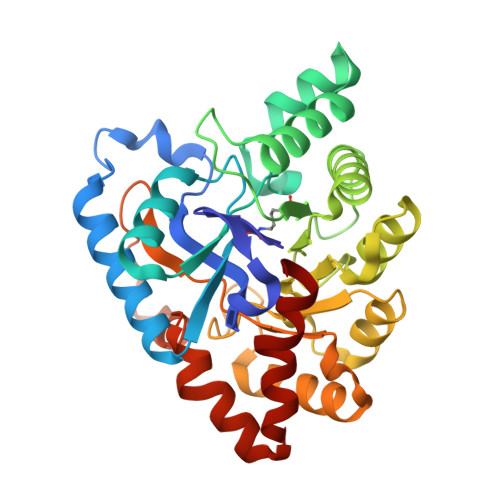Molecular engineering of organophosphate hydrolysis activity from a weak promiscuous lactonase template.
Meier, M.M., Rajendran, C., Malisi, C., Fox, N.G., Xu, C., Schlee, S., Barondeau, D.P., Hocker, B., Sterner, R., Raushel, F.M.(2013) J Am Chem Soc 135: 11670-11677
- PubMed: 23837603
- DOI: https://doi.org/10.1021/ja405911h
- Primary Citation of Related Structures:
4J2M, 4J35, 4J5N - PubMed Abstract:
Rapid evolution of enzymes provides unique molecular insights into the remarkable adaptability of proteins and helps to elucidate the relationship between amino acid sequence, structure, and function. We interrogated the evolution of the phosphotriesterase from Pseudomonas diminuta (PdPTE), which hydrolyzes synthetic organophosphates with remarkable catalytic efficiency. PTE is thought to be an evolutionarily "young" enzyme, and it has been postulated that it has evolved from members of the phosphotriesterase-like lactonase (PLL) family that show promiscuous organophosphate-degrading activity. Starting from a weakly promiscuous PLL scaffold (Dr0930 from Deinococcus radiodurans ), we designed an extremely efficient organophosphate hydrolase (OPH) with broad substrate specificity using rational and random mutagenesis in combination with in vitro activity screening. The OPH activity for seven organophosphate substrates was simultaneously enhanced by up to 5 orders of magnitude, achieving absolute values of catalytic efficiencies up to 10(6) M(-1) s(-1). Structural and computational analyses identified the molecular basis for the enhanced OPH activity of the engineered PLL variants and demonstrated that OPH catalysis in PdPTE and the engineered PLL differ significantly in the mode of substrate binding.
- Institute of Biophysics and Physical Biochemistry, University of Regensburg, Regensburg, Germany.
Organizational Affiliation:


















